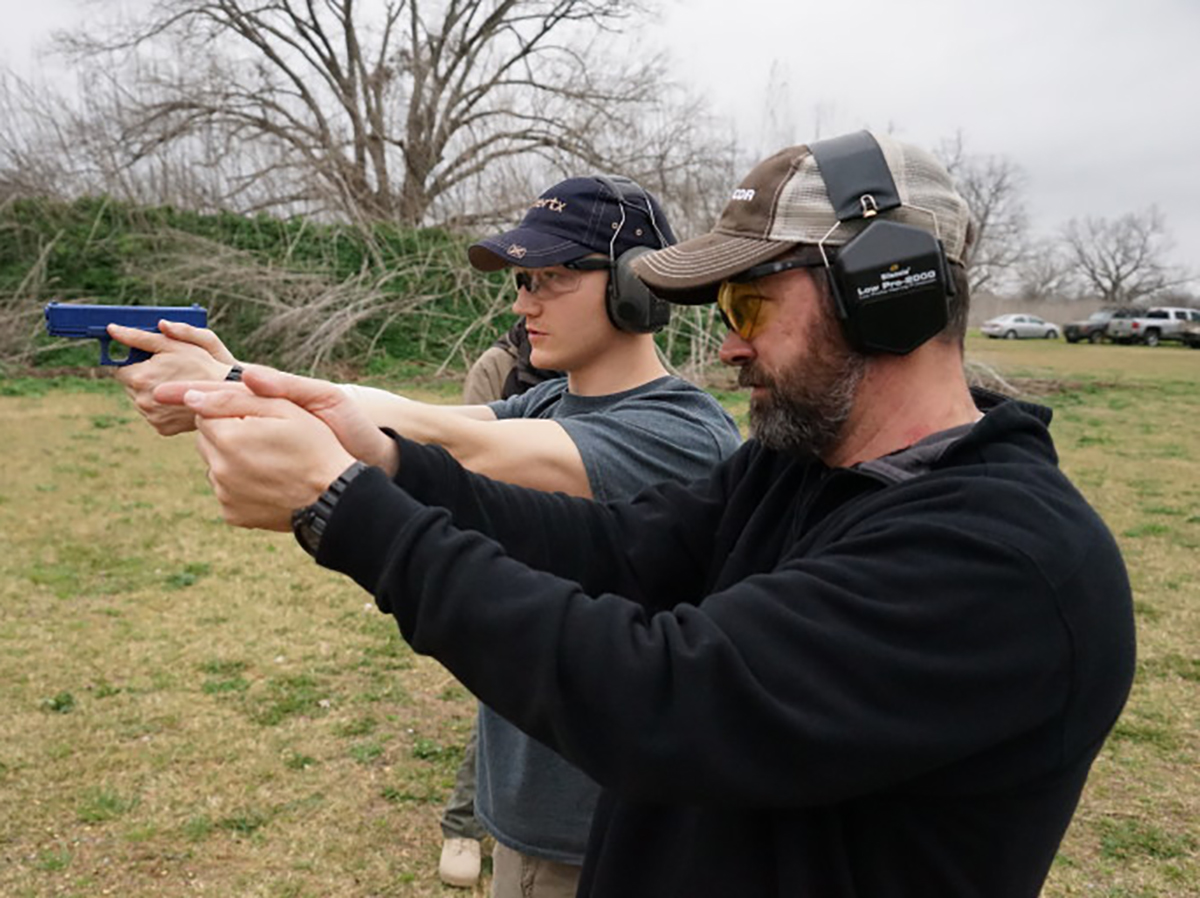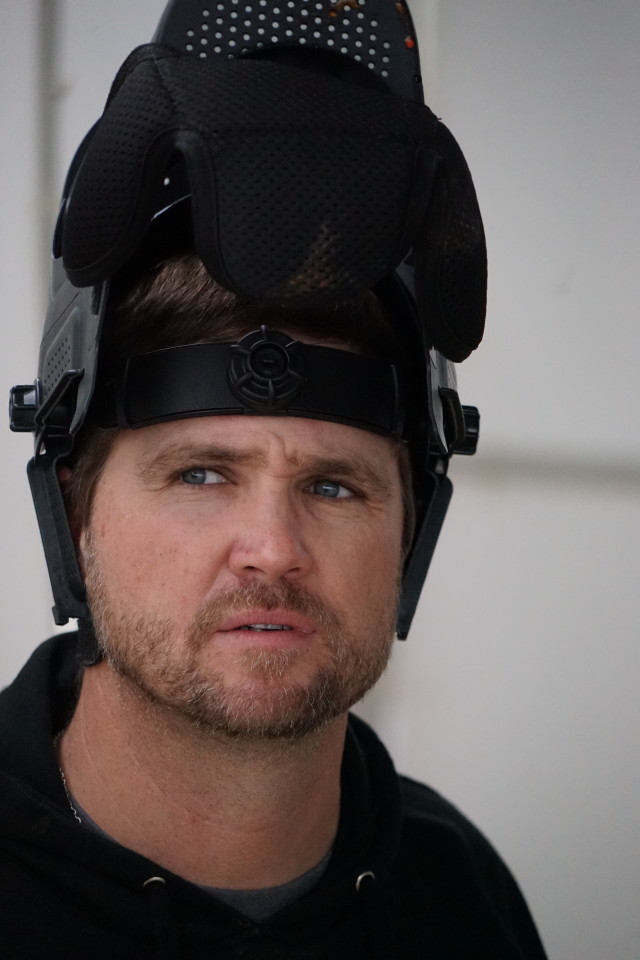Company Trains Civilians to Take Out Active Shooters
By Estefania Espinosa
Reporting Texas

Instructor Brazos Kellar (left) demonstrates proper and improper grip techniques to James Eastwood at the UpTex Shooting Range in Upton, Texas. Jack Vrtis/Reporting Texas
Matt, a coworker, and I hide in a room. We hear shots just outside the door. “I think he’s coming this way,” Matt says.
Matt draws his gun and tells me to get behind him. The ex-employee walks in and exchanges fire with Matt, who takes a few hits before the shooter goes down.
Matt asks if I’m OK, then tells me to call 911. “Tell them I’m wearing green khakis and a plaid shirt,” he says.
The exchange was a simulation, part of a class offered by Combative Weapon Solutions. Against a backdrop of more frequent mass shootings across the country, Combative Weapon founder and chief executive Lee Vernon, 42, an Austin firefighter, saw a need for tactical training for people who could fight back. Students are required to have a concealed weapon permit.
“Being a first responder and seeing how the world really is, what people are capable of doing, I realized the responsibility of carrying,” Vernon said. “There’s not enough training out there … that deals with actual events that happen in the real world.”
The class costs $250, but Vernon allowed Reporting Texas to participate free of charge.
Matt was Matt Cole, 33, a firearms instructor for another company, one of seven students applying what he learned. The shooter was Angelo Muscarella, 45, who works in airline grounds operations. Cole and Muscarella took turns playing the bad guy. They used paintballs, not live ammunition.
The FBI and other federal agencies define an “active shooter” as “an individual actively engaged in killing or attempting to kill people in a confined and populated area.”

Chris Compton waits for a cue from instructors before beginning a training exercise that will pit him against a mock shooter inside a makeshift office building. Jack Vrtis/Reporting Texas
Seventy percent of 160 active shooter events in the United States between 2000 and 2013 occurred in either a commerce/business or educational environment, and 60 percent ended before police arrived, according to an FBI study. In five of these incidents (3.1 percent), the shooting ended after armed individuals, who were not law enforcement officers, exchanged gunfire with the shooters. Only one of those civilians had a valid firearms permit.
***
Brazos Kellar, 24, a Combative Weapon Solutions instructor, played an unarmed bystander during a scenario where the shooter was inside the building and the armed civilian outside. Kellar was especially creative in defending himself — he used me as a human shield as he ran out of the “building.”
We hear the first shots. I scream and start heading for the door. Suddenly, I feel two hands on my shoulders.
Confused, I ask “What’s going on? Where are we going?”
Instead of answering, Kellar pushes toward the exit as he walks behind me. I see the armed civilian exchanging fire with the shooter a few feet in front of us. I know we’ll have to walk past them to get out.
Thankfully, the simulation ends before we reach them.
Once the shock wears off, I ask Kellar, “Would you have done that if this were real life?”
Without hesitation, he answers, “Of course. If I’ve got a wife and kids at home who are depending on me. I’ve got to think of my own safety.”
“Chivalry is truly dead,” I reply jokingly.
***
The class, offered at the UpTex shooting range in Smithville, had three parts: a free one-hour classroom session, a live-firing exercise using still targets and, after a 15-minute lunch break, active shooter simulations where instructors played bystanders and students played the shooter and the armed civilian. There were four different scenarios — disgruntled employee with armed civilian inside, shooter inside with armed civilian outside, boardroom meeting and store robbery.
The classroom session consisted of a curriculum developed by the Advanced Law Enforcement Rapid Response Center at Texas State University. Demand for the classes has increased, especially in the private sector, according to ALERRT officials.
Chris Gray, 39, an off-duty Austin police officer who led the classroom session, said people who have thought about what they would do in an active shooter situation are more likely to survive.
“Having a pre-existing plan drastically increases your chance to win,” Gray said.
Borrowing a concept developed by investigative journalist Amanda Ripley, author of “The Unthinkable: Who Survives When Disaster Strikes — And Why,” Gray identified three stages of disaster response — denial, deliberation and the decisive moment.
“We hear a loud sound and think to ourselves, ‘That must’ve been a car that backfired,’”Gray said. “The last thing on our mind, because we don’t live in the Gaza Strip, is ‘That had to have been a gunshot.’”
After overcoming denial, he said, get creative.
“Start thinking outside that box,” Gray said. “Go against the grain. Get out of that normalcy bias.”
Options in the decisive moment are to avoid, deny or defend, according to the ALERRT curriculum.
Avoid: “Know where your primary exit is,” Gray said. “Know any secondary exits should the primary exit be blocked.” Try to take others with you, but don’t let someone who wants to stay slow you down. Leave your belongings but make sure someone has a cell phone to call 911.
Deny: “Lock the door. Turn the lights off. Try to barricade that door with heavy furniture.”
Defend: “Finally as a last resort, if I can’t avoid and I can’t deny, it’s time to defend myself,” Gray said. “If I can avoid it or deny access, then those are the two preferences.” People who are unarmed should use improvised weapons, such as a fire extinguisher, office furniture, a sock with a snow globe in it, a belt or a purse.
During target practice, Justin Romberger, 33, a carbine instructor at CWS, explained why this part of the class is crucial. He said armed civilians who choose to defend themselves must have training because when people are in a high stress situation, their accuracy significantly decreases. They should continue to perfect their skills at gun ranges, even beyond the class, Romberger said.
A few days after the class, ALERRT program manager David Austin agreed to discuss the type of training Combative Weapon Solutions offers. He said licensed civilians can use their weapons as a defense without straying from the avoid, deny, defend strategy.
“If they’re faced with that situation, they have every right to defend themselves,” Austin said.
There are some risks for armed civilians after the active shooter event is over, he said.
“When the police show up, they’re going to have a hard time if they see two people with a gun,” Austin said. “[You should] follow commands of police officers, put your weapon down.”
To ensure their own safety, licensed carriers should never track down a shooter and should be properly trained, Austin said.
“When you get a license to carry, you get very minimal training,” Austin said. “My suggestion would be to seek additional training through companies that do stress shooting.”
Sgt. Jason Bryant, who is in charge of active shooter training at the Austin Police Department, answered a few questions about the kind of training Combative Weapon Solutions offers.
“When it comes time to defend, you are in a fight for your life,” Bryant said. “At that point, any weapon used to save your life or the life of another would be appropriate.”

An instructor shows a training pistol and magazine that are used in classes at the UpTex Shooting Range. The gun fires rounds that sting and leave a small orange mark on impact but do no permanent damage. Jack Vrtis/Reporting Texas
Bryant said there are downsides and possible risks for those who are armed in active shooter events.
“The scenes of active shootings are chaotic at best, and the possibility of mistaken identities or confusion of who is the bad guy and who is the CHL holder or good guy could be easily confused,” he said.
***
Student Tyler Smith, 46, had no trouble remembering the avoid strategy in a recent training session; he ran away when he heard the shots coming from his office building in the second scenario. CWS instructors said they’d never seen a student react that way before. Gray said it was still an appropriate response under the avoid, deny, defend strategy.
He reminded armed civilians to mention their clothes in 911 calls so police officers are able to identify them.
“It would suck to save the day only to get shot by the responding law enforcement officers that are coming in.”